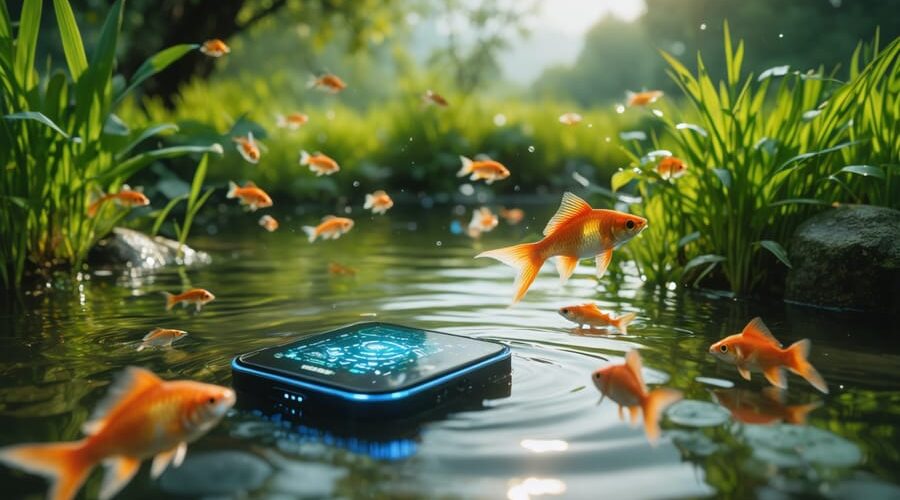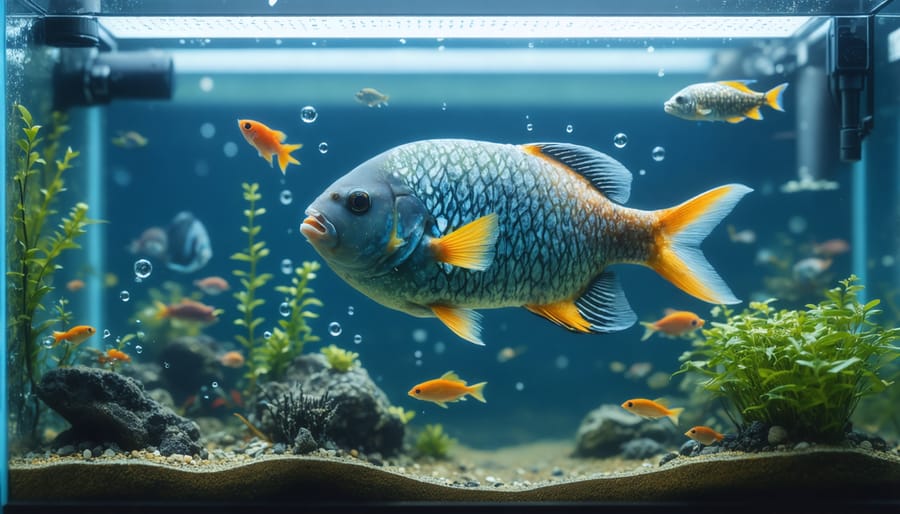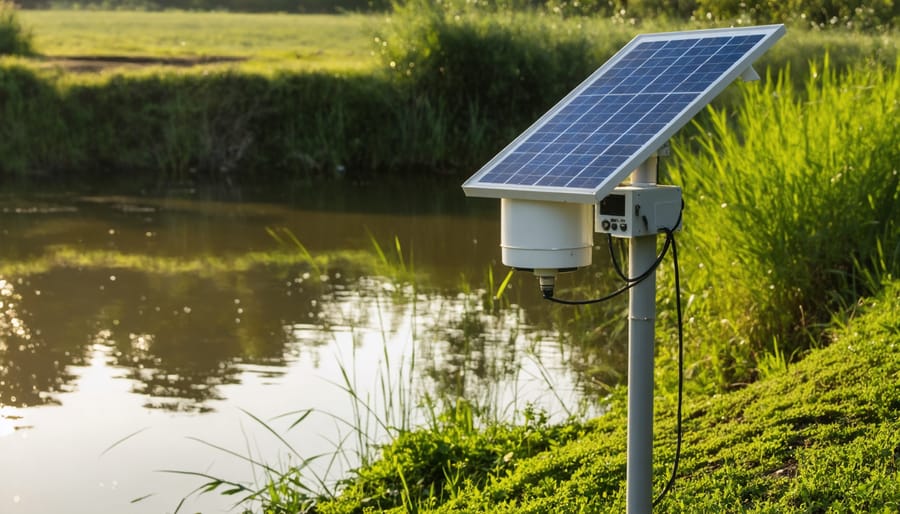
Smart Pond Tracking: How Biometric Sensors Are Revolutionizing Wildlife Monitoring
Transform your pond maintenance with biometric sensors that continuously monitor water quality, fish health, and ecosystem balance in real time. These advanced smart pond monitoring systems detect subtle changes in temperature, pH, oxygen levels, and fish behavior before problems become visible to the naked eye.
Unlike traditional testing methods that provide only periodic snapshots, biometric sensors deliver round-the-clock surveillance of your pond’s vital signs through wireless connectivity. Place sensors strategically near filter systems, plant zones, and fish gathering areas to create a comprehensive health profile of your water garden. Receive instant mobile alerts when conditions drift outside optimal ranges, allowing you to address issues before they impact your pond’s delicate ecosystem.
For pond enthusiasts seeking peace of mind, these user-friendly devices eliminate the guesswork from water quality management while protecting your valuable fish and plants. The technology works silently in the background, giving you more time to enjoy your water garden rather than worry about its maintenance.
Understanding Biometric Sensors for Ponds
Types of Pond Biometric Sensors
Several types of biometric sensors help pond owners keep a watchful eye on their aquatic friends. Temperature sensors are among the most common, letting you monitor water conditions that affect fish activity and breeding cycles. These handy devices can alert you when temperatures drift outside the ideal range for your pond inhabitants.
Dissolved oxygen sensors are another crucial tool, measuring the amount of oxygen available to your fish and other aquatic life. Like us, fish need proper oxygen levels to thrive, and these sensors help ensure they’re getting enough of it.
Motion detection sensors can track fish movement patterns and help spot unwanted predators near your pond. Some advanced models even use infrared technology to work at night, giving you round-the-clock monitoring capabilities.
pH sensors keep tabs on your water’s acidity levels, which is vital for maintaining healthy living conditions for both fish and plants. These sensors can help you catch potential problems before they affect your pond’s ecosystem.
For those interested in detailed monitoring, there are also sensors that measure ammonia levels, nitrates, and water clarity. While these might seem fancy, they’re becoming more user-friendly and affordable for the average pond owner. Many modern sensors can now connect to your smartphone, making it easier than ever to keep your pond paradise healthy and thriving.

How These Sensors Work
Biometric sensors work by detecting and measuring specific biological characteristics of your pond’s inhabitants. These clever devices use various methods to collect data, similar to how a digital thermometer reads temperature, but with more sophisticated technology. For fish monitoring, optical sensors use light to capture images of scales, fin patterns, and size, while motion sensors track swimming patterns and behavior.
Some sensors work through direct contact with the water, measuring chemical signatures that indicate the presence and health of different species. Others use sound waves to detect movement and count fish populations, much like a boat’s fish finder. More advanced sensors can even detect the electrical signals naturally produced by fish as they swim.
The collected data is then processed by specialized software that converts these readings into useful information about your pond’s inhabitants. This might include population counts, growth rates, or unusual behavior patterns that could indicate health issues. Think of it as having a high-tech wildlife camera that works underwater, giving you a clear picture of your pond’s ecosystem without disturbing its natural balance.
Benefits for Your Pond Ecosystem
Health Monitoring Made Easy
Modern biometric sensors make watching over your pond fish as easy as checking your smartphone! These clever devices work like underwater health monitors, keeping track of your finned friends’ vital signs and daily routines. They can detect changes in swimming patterns, eating habits, and even stress levels – giving you early warnings if something’s not quite right.
Think of these sensors as tiny lifeguards for your pond. They continuously measure water quality parameters while also monitoring your fish’s behavior. When a fish starts swimming unusually or shows signs of distress, the sensors pick up on these changes immediately. You’ll get alerts before small issues become big problems, which is especially helpful during breeding seasons or when introducing new fish to your pond.
The best part? Most modern sensors connect to your mobile device, letting you check on your fish even when you’re away. They can track multiple fish at once and store data over time, helping you understand your pond’s patterns and your fish’s individual personalities. It’s like having a fish doctor on duty 24/7, giving you peace of mind and helping ensure your aquatic pets stay happy and healthy.

Early Warning System
Think of biometric sensors as your pond’s early warning system, constantly monitoring vital signs to catch potential issues before they become serious problems. These smart devices work tirelessly to track water quality, temperature fluctuations, and even fish behavior patterns, making preventive pond maintenance easier than ever.
When ammonia levels start creeping up or oxygen levels dip below optimal ranges, these sensors send alerts straight to your smartphone or control panel. It’s like having a 24/7 pond expert keeping watch over your aquatic paradise. For example, if water temperature begins to rise unusually fast on a hot day, you’ll know to add shade or adjust your cooling system before your fish show signs of stress.
These sensors can also detect subtle changes in fish movement patterns, which often indicate potential health issues before visible symptoms appear. By catching these warning signs early, you can take corrective action quickly, potentially saving both time and money while ensuring your pond inhabitants stay healthy and happy.
Setting Up Your First Sensor System

Choosing the Right Sensors
When selecting biometric sensors for your pond, consider three key factors: pond size, fish species, and monitoring needs. For smaller ponds under 1,000 gallons, a basic sensor package monitoring temperature and oxygen levels usually suffices. Larger ponds benefit from more comprehensive systems that track additional parameters like pH and ammonia levels.
Different fish species have varying sensitivities to water conditions. Koi, for instance, require precise temperature monitoring and benefit from sensors that can detect subtle changes quickly. On the other hand, hardier fish like goldfish may only need basic parameter tracking.
To maintain an optimal pond ecosystem, match your sensors’ capabilities to your specific needs. If you’re breeding sensitive species, invest in high-precision sensors with real-time alerts. For general pond keeping, standard sensors checking basic parameters will work well.
Consider also the sensor’s placement options and wireless range if you’re planning to monitor remotely. Look for weather-resistant models with good battery life, and ensure they’re compatible with your preferred monitoring system or smartphone app.
Biometric sensors have revolutionized the way we care for our ponds and their inhabitants, making it easier than ever to maintain a thriving aquatic ecosystem. By monitoring vital signs and behavioral patterns, these innovative devices give us unprecedented insight into the well-being of our fish and other pond life. The real-time data they provide allows us to catch potential problems early, adjust conditions promptly, and create the perfect environment for our aquatic friends to flourish.
Whether you’re a seasoned pond keeper or just starting your water gardening journey, implementing biometric sensors can take much of the guesswork out of pond maintenance. The investment in these tools often pays for itself through reduced fish loss, optimized feeding schedules, and more efficient resource management. Plus, the peace of mind that comes from knowing your pond’s inhabitants are healthy and happy is truly priceless.
Consider taking the first step toward smarter pond management by incorporating biometric sensors into your setup. Your fish will thank you, and you’ll wonder how you ever managed without them. Start small with basic monitoring devices and gradually expand your system as you become more comfortable with the technology. The future of pond keeping is here – embrace it and watch your water garden thrive!
